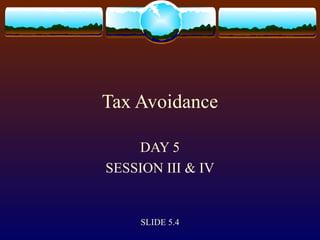
Tax avoidance 5.4
- 1. Tax Avoidance DAY 5 SESSION III & IV SLIDE 5.4
- 2. Tax Planning Tax planning can be defined as an arrangement of one’s financial and economic affairs by taking complete legitimate benefit of all deductions, exemptions, allowances and rebates so that tax liability reduces to minimum SLIDE 5.4
- 3. Tax Planning Thus, all such arrangements by which the tax laws are fully complied and which meet all legal obligations and transactions (both individually and as a whole), representing tax planning not taking form of “colourable devices” and having no intention to deceit the legal spirit behind the tax law, would naturally fall within the ambit of tax planning. SLIDE 5.4
- 4. Tax Planning Colourable devices cannot be part of tax planning and it is wrong to encourage or entertain the belief that it is honourable to avoid payment of tax by resorting to dubious methods [McDowell & Co. Ltd. v. CTO [1985] 154 ITR 148 (Supreme Court)] SLIDE 5.4
- 5. Tax Planning Tax planning should not be done with an intent to defraud the revenue; though all transactions entered into by an assessee taken individually could be legally correct, yet on the whole these transactions may be devised to defraud the revenue Thus, planning for tax should be correct both in form and substance SLIDE 5.4
- 6. Colorable Devices All such methods which are resorted to deceive and impairing the true construction of the statute, resulting in availing non-sacrosanct advantage of law would be termed as colourable devices. Those devices where statute is followed in strict words but actually spirit behind the statute is marred would be termed as colourable devices. SLIDE 5.4
- 7. Tax authorities’ powers and responsibilities The taxing authority is entitled and is indeed bound to determine the true legal relation resulting from a transaction. If the parties have chosen to conceal by a device the legal relation, it is open to the taxing authorities to unravel the device and to determine the true character of relationship. But the legal effect of a transaction cannot be displaced by probing into substance of the transaction. SLIDE 5.4
- 8. Tax avoidance The line of demarcation between tax planning and tax avoidance is very thin and blurred. There is an element of mala fide motive involved in tax avoidance. Any planning of tax which though done strictly according to legal requirement but defeats the basic intention of the Legislature behind the statute could be termed as instance of tax avoidance. SLIDE 5.4
- 9. Tax avoidance Criteria to define tax avoidance (1) use of colorable devices; (2) instances where doctrine of substance is defeated; (3) defeating the genuine spirit of law; (4) mis-representation or twisting of facts; (5)taking only strict interpretation of law and suppressing the legislative intent behind it. SLIDE 5.4
- 10. Tax avoidance Tax planning is a perfectly legitimate exercise if it complies with under-mentioned ingredients Tax planning should reflect the basic intention of Legislature behind the statute. 2. Tax incentives availed of by the assessee is within the ambit of legitimate tax planning. 3. Planning of financial affairs by a series of transactions (doctrine of form) each having individual legitimacy and composite effect produced as a whole (doctrine of substance) following the true spirit of law is perfectly legitimate. 4. Tax planning should not involve use of colourable devices for reducing tax liability. SLIDE 5.4
- 11. Tax Evasion All methods by which tax liability is illegally avoided are termed as tax evasion. An assessee guilty of tax evasion may be punished under the relevant laws. SLIDE 5.4
- 12. Tax Evasion Tax evasion may involve stating an untrue statement knowingly, submitting misleading documents, suppression of facts, not maintaining proper accounts of income earned (if required under law), omission of material facts on assessment. SLIDE 5.4
- 13. Tax Evasion All such procedures and methods are required by the statute to be abided with but the assessee who dishonestly claims the benefit under the statute before complying with the said abidance by making false statements, would be within the ambit of tax evasion. SLIDE 5.4
